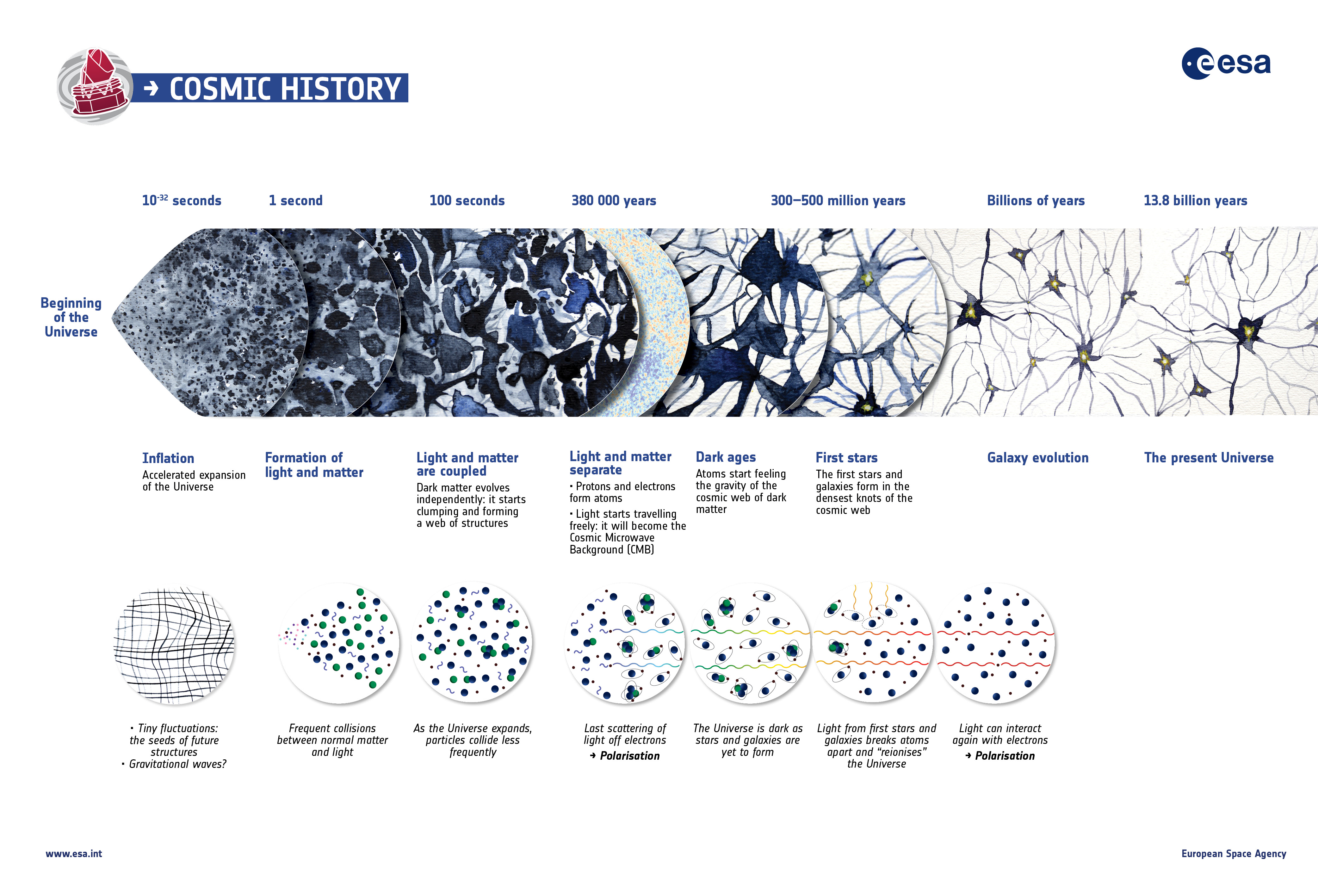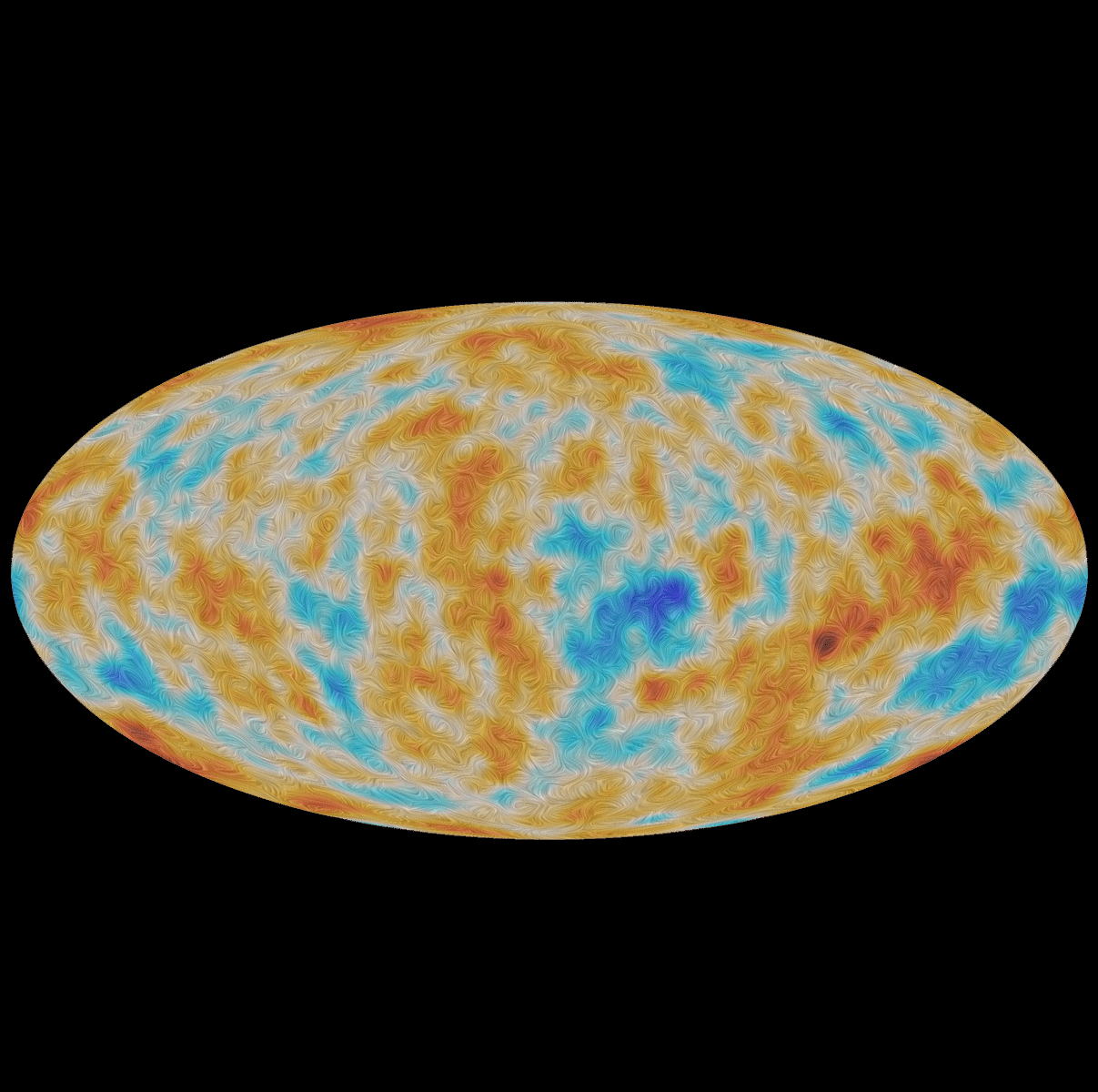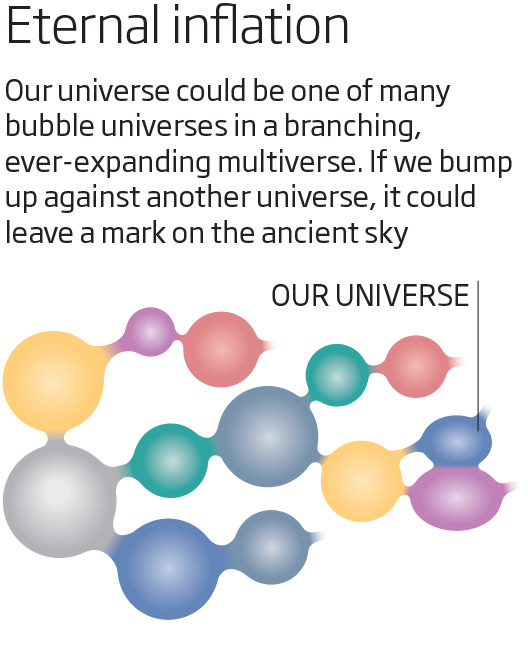Where's
@m1dg3t ?
Mystery bright spots could be first glimpse of another universe
Light given off by hydrogen shortly after the big bang has left some unexplained bright patches in space. Are they evidence of bumping into another universe?
The curtain at the edge of the universe may be rippling, hinting that there's more backstage. Data from the ESA's Planck telescope could be giving us our first glimpse of another universe, with different physics, bumping up against our own.
Armed with Planck's painstaking map of the CMB – light lingering from the hot, soupy state of the early universe – Ranga-Ram Chary, a researcher at Planck's US data centre in California, revealed an eerie glow that could be due to
matter from a neighbouring universe leaking into ours.
This sort of collision should be possible, according to modern cosmological theories that suggest the
universe we see is just one bubble among many. Such a multiverse may be a consequence of cosmic inflation, the widely accepted idea that the
early universe expanded exponentially in the slimmest fraction of a second after the big bang.
Once it starts, inflation never quite stops, so a multitude of universes becomes nearly inevitable. “I would say most versions of inflation in fact lead to eternal inflation, producing a number of pocket universes,” says Alan Guth of the MIT, an architect of the theory.
Energy hidden in empty space drives inflation, and the amount that's around could vary from place to place, so some regions would eventually settle down and stop expanding at such a manic pace. But the spots where inflation is going gangbusters would spawn inflating universes. And even areas within these new bubbles could balloon into pocket universes themselves.
Like compositions on the same theme,
each universe produced this way would be likely to have its own spin on physics. The matter in some bubbles – the boring ones – would fly apart within 10^-40 seconds of their creation. Others would be full of particles and rules similar to ours, or even exactly like ours.
In the multiverse of eternal inflation, everything that can happen has happened – and will probably happen again.
That notion could explain why the physical constants of our universe seem to be so exquisitely tuned to allow for galaxies, stars, planets and life.
Sadly, if they do exist, other bubbles are nigh on impossible to learn about. With the space between them and us always expanding, light is too slow to carry any information between different regions.
However,
if two bubbles started out close enough that they touched before expanding space pushed them apart forever, they could leave an imprint on each other.
In 2007, Matthew Johnson of York University in Toronto, Canada and his PhD adviser proposed that these
clashing bubbles might show up as circular bruises on the CMB. They were looking for cosmic dance partners that resembled our own universe, but with more of everything. That would make a collision appear as a bright, hot ring of photons.
By 2011, they were able to search for them in data from WMAP probe. But they came up empty-handed.
Now Chary thinks he may have spotted a different signature of a clash with a foreign universe.
Instead of looking at the CMB itself, Chary subtracted a model of the CMB from Planck's picture of the entire sky. Then he took away everything else, too: the stars, gas and dust.
With our universe scrubbed away, nothing should be left except noise. But in a certain frequency range, scattered patches on the sky look far brighter than they should. If they check out, these anomalous clumps could be caused by cosmic fist-bumps: our universe colliding with another part of the multiverse.
These patches look like they come from the era a few hundred thousand years after the big bang when electrons and protons first joined forces to create hydrogen, which emits light in a limited range of colours. We can see signs of that era, called recombination, in the light from that early hydrogen. Studying the light from recombination could be a unique signature of the matter in our universe – and potentially distinguish signs from beyond.
Since this light is normally drowned out by the glow of the CMB, recombination should have been tough for even Planck to spot. But Chary's analysis revealed
spots that were 4500 times as bright as theory predicts.
One exciting explanation for this is if a surplus of protons and electrons – or something a lot like them – got dumped in at the point of contact with another universe, making the light from recombination a lot brighter. Chary's patches require the universe at the other end of the collision to have roughly 1000 times as many such particles as ours. It will be important to carry out an independent analysis and confirm this finding.
An experiment that could help might be on its way. Scientists at NASA's Goddard Space Flight Center plan to submit
PIXIE, the Primordial Inflation Explorer, to be considered for funding at the end of 2016.
Just right for life?
If our universe is just one of many, that could explain why it seems so exquisitely tuned for our existence.
If dark energy, the repulsive influence hiding in empty space that speeds up the expansion of the universe, were just a little stronger, matter would be flung apart before galaxies could ever form. If it were attractive instead, the universe would collapse. But it is shockingly puny, and that's weird, unless
our universe is one of many in the multiverse.
Compared with what we might expect from quantum theory, dark energy is 120 orders of magnitude too small. So far, no compelling explanation for that discrepancy has emerged. But if the multiverse exists, and dark energy varies from bubble to bubble, that might not seem so strange.
That's because our own universe might be an oddball compared to most bubbles. In many, dark energy would be too strong for galaxies, stars and planets to form, but not in all. “Plenty of them would have energies as small as what we observe,” says physicist Alan Guth of MIT.
That still leaves us struggling to explain why our universe is one of the special ones. Our best answer so far, Guth says, is a philosophical headache: our universe has to be special because we are alive in it. In a more average region, where dark energy is stronger, stars, planets, and life would never have evolved.
That could mean life only exists in a sliver of the multiverse, with any conscious beings convinced their own slice of space is special, too.
https://www.newscientist.com/articl...s-could-be-first-glimpse-of-another-universe/ WMAP is fantastic, nine years of observations are not wasted.
WMAP is fantastic, nine years of observations are not wasted. WMAP is fantastic, nine years of observations are not wasted.
WMAP is fantastic, nine years of observations are not wasted.








 Universe is even more complex than we thought or maybe not ... Go figure
Universe is even more complex than we thought or maybe not ... Go figure
 Yup I'm more in astrophysics and astronomy than ever before!
Yup I'm more in astrophysics and astronomy than ever before!







